When I was a kid, I loved summer; now I love money. When your pockets are full, summer days may never end. Indeed, there are so many sunny cities in Europe inviting you to enjoy warm weather even in January. If you are a summer child and feel depressed from the chill, save this list for those days because we are going to talk about the top 10 sunny cities in Europe.
These cities offer more than just pleasant weather; they provide a vibrant lifestyle and are perfect for those looking to soak up the sun. And I wonder whether the sun makes these cities so vibrant or has such cultural quality.
Sunny cities in Europe ☀️
Today, let’s talk about the sun, not the one you enjoy on the beach, but the one you use to generate solar energy. In short, let’s see how Europe’s sunniest cities use solar energy and how much they are sustainable.
What is it like to live in a sunny city?
It is true; people are happier when it is sunny. It is chemistry, maybe, but waking up in the sunshine works as a mood booster. Whether it is morning in Malaga, noon in Yerevan, or sunset in Lisbon, the sun is life, the sun is the passion and energy we always need.
Malaga, Spain
Located in Spain’s Costa del Sol, Malaga enjoys 300 sunny days a year. It means you can hardly catch bad weather here. The subtropical Mediterranean climate with very mild winters, hot summers, and fantastic beaches make Malaga ideal for all-year-round vacation.
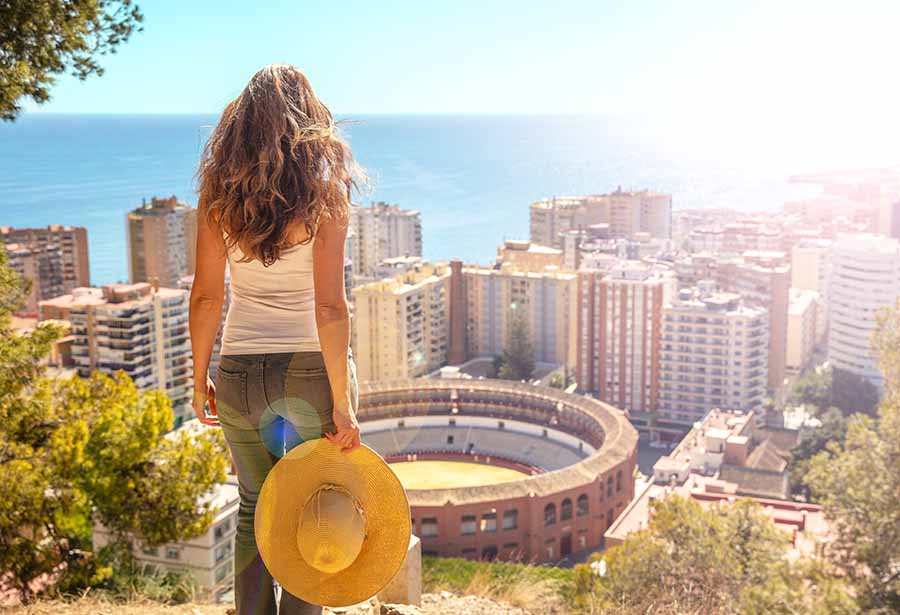
How does Malaga use solar energy?
Malaga is a leader in Spain’s solar energy movement, already producing renewable energy to power 500.000 households. With 3000 sunny hours, longer daylight hours, and intense sunlight, each kilowatt of solar capacity generates 9.93 kWh per day. Spain is committed to achieving climate neutrality by 2050, and to achieve this goal, it is actively working on the development of its renewable energy sector. The country aims to fully transition to renewable electricity by 2050, and while wind power is currently the leading renewable energy source, solar energy is rapidly growing. Over the last five years, the installed solar capacity in Spain has quadrupled, making it the fifth-largest installer of new solar capacity globally in 2022. This remarkable surge in solar energy positions it as a key player in Spain’s renewable energy future.
And some travel info
- Enjoy the sun on La Malagueta Beach, Malaga’s main beach, perfect for sunbathing and water sports.
- Shop souvenirs and designer pieces at Calle Larios, the main shopping street.
- Try Porra Antequerana, thick tomato soup served cold with ham and eggs.
- Malaga’s top insta-spots are hilarious and the list will guide you there.
- To the heart of Spain, Malaga can be reached by budget airline flights, by land and even on foot.
Nice, France
The jewel of the French Riviera, known for its stunning beaches, enjoys mild Mediterranean weather with 300 sunny days. Ideal for embracing Nice with its famous promenades, art galleries, and outdoor cafes any time of the year.
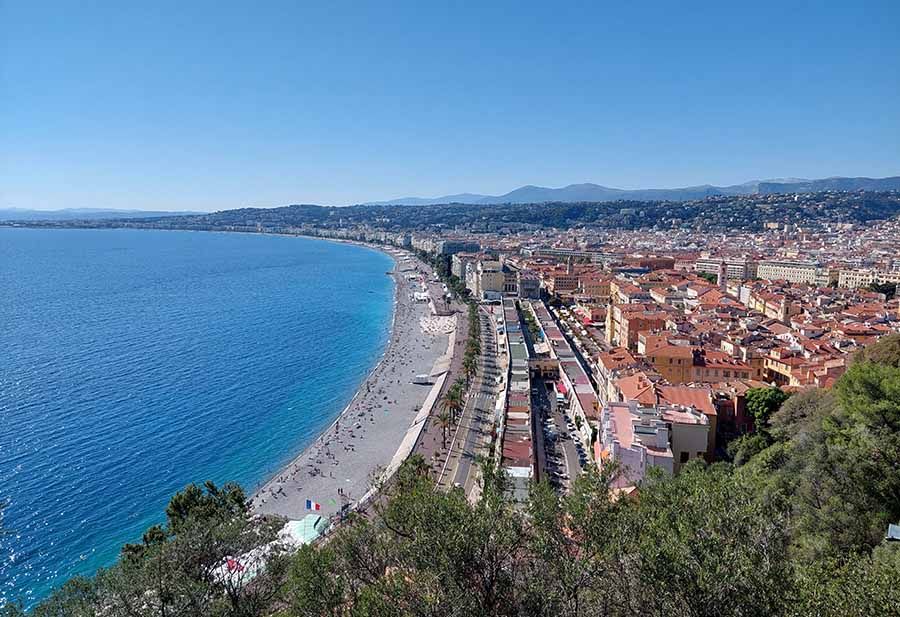
How does Nice use solar energy?
Solar energy in France has been growing steadily in recent years, with the country aiming to produce 32% of its energy from renewable sources by 2030. As for Nice, the local government has been promoting the use of solar panels on rooftops and in public spaces to use this renewable energy source. One of the initiatives in Nice is the installation of solar panels on public buildings and infrastructure, such as the airport and tram stations. These solar panels help to reduce the city’s carbon footprint and reliance on fossil fuels.
And some travel info
- Embrace the sun at Promenade des Anglais, a famous walkway along the Nice coastline.
- Explore the vibrant colors and scents at the Cours Saleya Flower Market, a true feast for the senses.
- Sample the iconic Salade Niçoise with the freshest local ingredients.
Napoli, Italy
Located in southern Italy, Napoli enjoys a Mediterranean climate with over 250 sunny days each year. The climate is characterized by hot, dry summers and mild, wet winters. Napoli combines deep cultural heritage with a lively urban vibe, all against the backdrop of Mount Vesuvius.
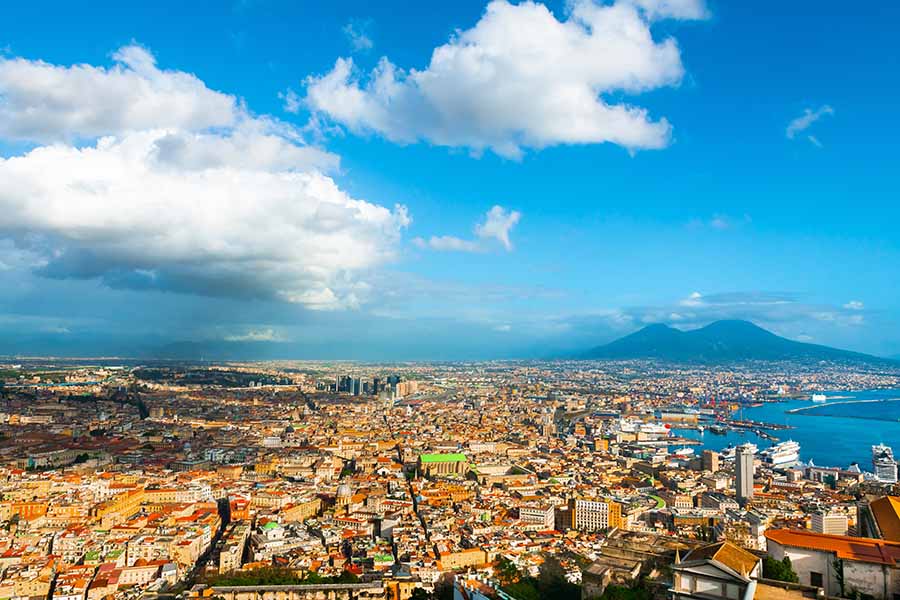
How does Napoli use solar energy?
While Italy has been slower to adopt solar energy compared to other European countries, Napoli has increased the implementation of solar panels, particularly in residential areas. In 2020, solar energy covered 8.2% of electricity consumption. A year later, the number reached 11%. As for Napoli, most solar panels are installed in poor neighborhoods to support families with low incomes and raise environmental awareness.
And some travel info
- Visit the historic sites of Pompeii and Herculaneum under sunny skies.
- Enjoy a leisurely walk along Spaccanapoli, a street lined with churches, shops, and pizzerias.
- Taste authentic Neapolitan pizza, where the tradition of pizza making continues.
- You can start to plan your trip to Napoli from this page finding the best dates of flights on the calendar.
- And if you wish to try all available pizzas and pastas in Napoli, here is your quick guide for that experience.
Heraklion, Crete, Greece
Located on the island of Crete, Heraklion gives you laid-back vibes with a fantastic mix of history and modern comfort. All these are enjoyed under the hot sun for 300 days each year. The Mediterranean climate here features hot, dry summers and mild winters, making it perfect for year-round visits.
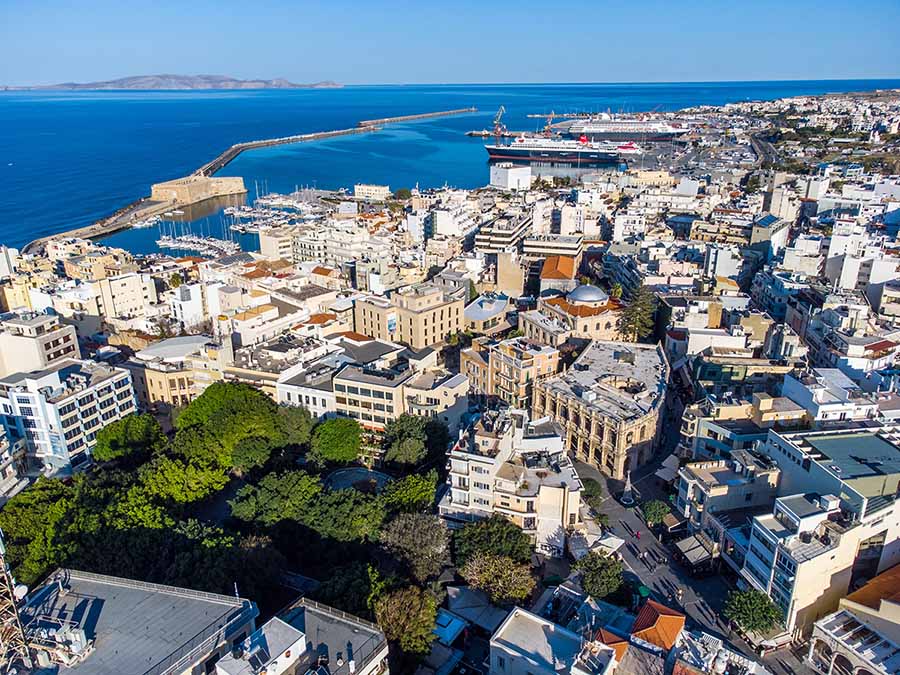
How does Heraklion use solar energy?
Crete has been proactive in using solar energy. Moreover, in past years, the island has been working on producing enough renewable energy from wind and sun to support the mainland’s power grid. The island has numerous solar power installations and solar parks that contribute significantly to its energy supply. These efforts are aimed at reducing CO2 emissions by 30% and solving the issue of power shortages once and for all.
And some travel info
- Explore the ancient ruins of Knossos, just outside Heraklion. t is a glimpse into Europe’s oldest civilization.
- Stroll along the Venetian walls and harbor for beautiful views and a taste of the city’s history.
- Try local dishes like moussaka and dakos at a seaside taverna while enjoying the sunshine.
- Here you can compare all flights to Heraklion and find the best price for your trip.
Yerevan, Armenia
The Ararart Valley, where Yerevan is located, is renowned for the hottest sun, especially during the summer months. The highland continental climate gives Yerevan 3531.73 hours of sunshine each year, with hot summers and cold, snowy winters. And, because of this heating sun, Armenia has the sweetest, juiciest, and most aromatic fruits and vegetables.

How does Yerevan use solar energy?
Armenia’s significant solar energy potential is already being used to produce renewable energy. Compared to the European average of 1000 kWh, Armenia has an average annual solar energy flow of 1720 kWh. Utility-scale polar PV plants are already operating in other regions across Armenia. One of the biggest initiatives is the first experimental floating solar plant development program on Yerevan Lake, with a capacity of 150 kW. The private sector and residents slowly but steadily move to renewable energy, installing solar panels as a way to get access to cheaper energy and contribute to sustainable energy initiatives.
And some travel info
- Walk the steps of the Cascade, a massive stairway with fountains and sculptures, and take pictures of unique contemporary art sculptures at the Cafesjian Center of the Arts.
- Shop for vintage and Armenian handicrafts at Vernissage’s open-air flea market.
- Drink Armenian coffee and wine, and make “brduch” with lavash bread to enjoy outdoors, where the food tastes even better with a dose of Vitamin D.
- By the way, Armenian dishes will pleasantly surprise you with their diversity and variety, which you will hardly find anywhere else (unless you have found yourself in the Armenian quarter of any European city).
- Taste a variety of Armenian wines and celebrate one of the best days in Yerevan – Wine Days.
- The destinations to Yerevan have doubled in recent years and many direct flights are available from European cities.
- Here you can find Yerevan hotels selected by a tourism expert living in Yerevan․
Nicosia, Cyprus
The brightest capital of Europe, Nicosia, is a favorite year-round option for travel. Its hot, semi-arid climate, with long, hot summers and mild to cool winters, has 300 sunny days per year. No wonder why the lifestyle here has a unique vibe, vibrant during the day and softer, just like the soft breeze at night.

How does Nicosia use solar energy?
Cyprus is one of Europe’s leading users of solar energy, with energy-efficient houses. 3.3% of Cyprus’ total energy comes from solar PV, making it the 27th in the world using renewable energy. But it is just the beginning. The government heavily invests in renewable energy, and the latest project is the new photovoltaic park in Nicosia with over 80.000 panels and a total capacity of 56 MW.
And some travel info
- Find souvenirs and the best deals at Ledra Street, feel the taste of Cyprus, and then get lost in the narrow alleys of the Old City.
- Enjoy traditional Cypriot coffee at one of the open terraces of the Old City, like Halara Cafe or Tria Fanaria.
- Taste traditional Cypriot dishes like souvla and halloumi at a local taverna, enhanced by the pleasant Mediterranean climate.
- See more on things you should know about Nicosia.
Bucharest, Romania
Bucharest with its unique blend of Eastern European heritage and Western influences, is becoming a new hot European destination not only for parties but for nature and its sun. With 2228 hours of sunlight per year and a humid continental climate, the capital of Romania may become one of the top European cities using renewable energy as the major energy source.
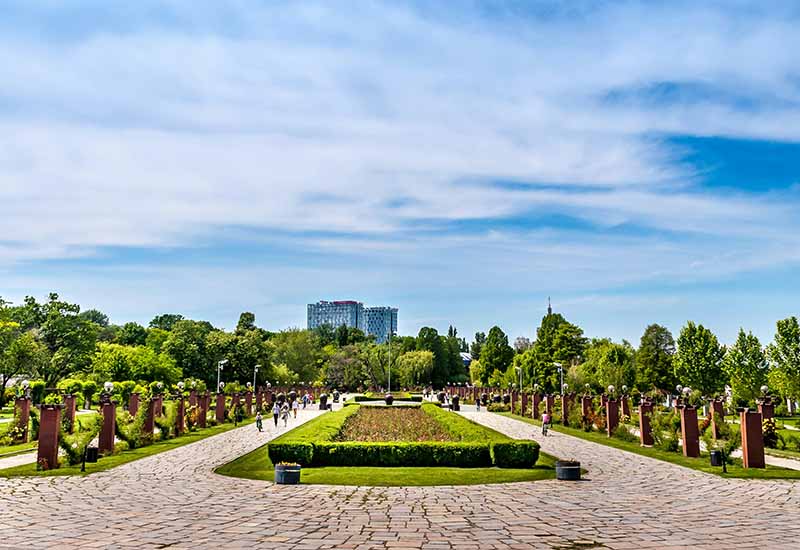
How does Bucharest use solar energy?
By 2022, solar energy was used only by the private sector on a small scale. In 2022, Israeli-based Nofar Energy built the largest solar power plant west of Bucharest, occupying 170 hectares with an output of 220 GWh. By 2030, the country plans to heavily invest in solar energy by increasing the number of power plants and boosting power capacity by 3.6 GW.
And some travel info
- Here we convince you to pack your bags for a trip to Bucharest.
- Explore the youngest Old Town in Europe with street cafes, restaurants, and bars.
- Visit the most beautiful Caru’ cu Bere (The Beer House) restaurant, renowned for its traditional Romanian cuisine, lively atmosphere, and the best beer in the town.
- Enjoy the mixture of German, Hungarian, and Turkish cuisines by tasting the national Ciorba de burta, kumari (pork greaves), and papanasi.
- And here is the list of cheap direct flights to Bucharest.
Budva, Montenegro
Budva is one of Montenegro’s most treasured resorts and a jewel of the Mediterranean. Known for its medieval town, beautiful beaches, and sunny weather, Budva enjoys over 240 sunny days per year, making it an excellent year-round travel destination. By the way, Budva is undeservedly underrated and less popular, which means there are no crowds.
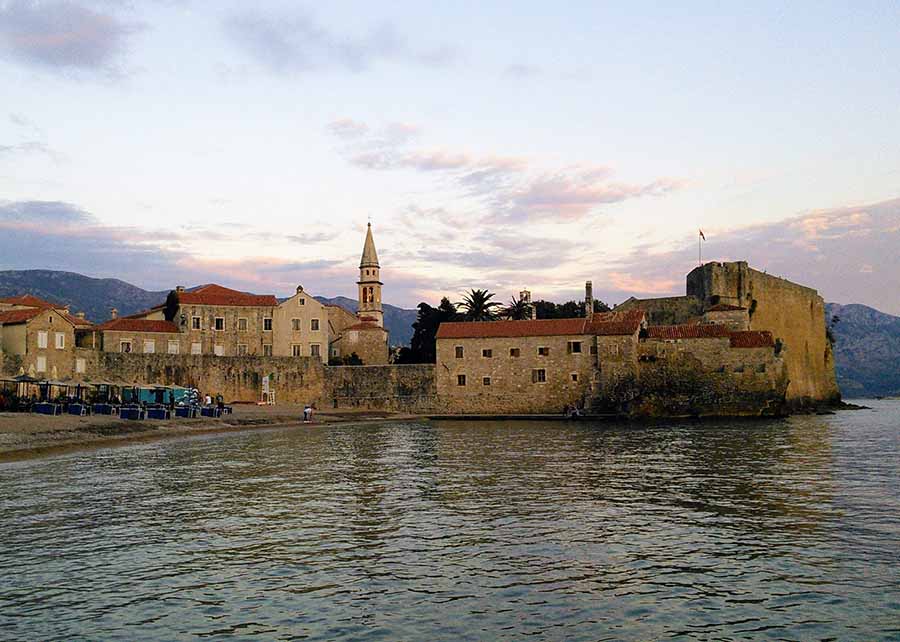
How does Budva use solar energy?
Montenegro is increasingly investing in solar energy to support its green tourism initiatives. With an average daily output of 7.61 kWh (summer months) per KW of solar capacity, the city infrastructure has all the potential to be supported by renewable energy. Budva has implemented several solar initiatives, including solar-powered public lighting and small-scale solar plants on hotel rooftops.
In 2019, the local government implemented the “Smart City Concept,” a pilot project of smart solar benches across the city to accumulate solar energy. Residents can use the benches to charge devices wirelessly or with a USB cable.
Today, over 3000 households and 500 business entities are powered by solar energy, reducing CO2 emissions and their reliance on traditional energy sources. The country plans to develop larger solar energy projects as part of its commitment to reach 33% renewable energy by 2030.
And some travel info
- Stroll through Budva’s charming Old Town, relax on Mogren Beach, or visit the island of Sveti Nikola for a day of adventure.
- Experience Budva from a bird’s-eye view while paragliding along the coast.
- Taste the fresh seafood at Jadran Kod Krsta, with its stunning views of the Adriatic, or enjoy the vibrant nightlife at Top Hill, one of the hottest nightclubs in the area.
- Meet the ballerina at the beach.
- There are many hotels available in Budva for both budget and luxury vacations․
València, Spain
València, a mix of nature and a futuristic complex of museums, cinemas, and theaters, is on the list of favorite travel destinations for its subtropical Mediterranean climate with very mild winters and long, warm-to-hot summers. With 300 sunny days in a year, Valencia can claim the title of a sustainable city with solar energy production.
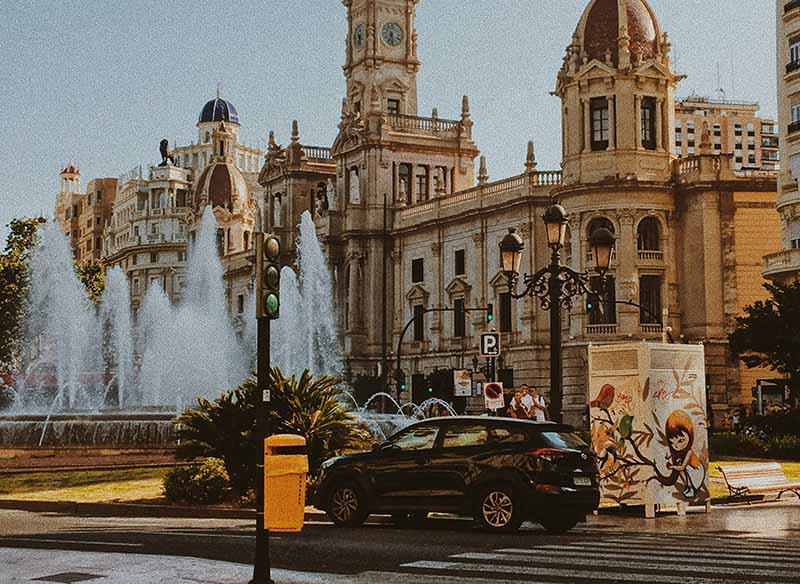
How does València use solar energy?
Spain has been a leader in solar energy, and Valencia is at the forefront of this trend. The latest news in the industry is the installation of solar panels at the port of València, which already generates 22% of consumable energy. It is projected to make the port entirely green.
To encourage residents to switch to solar energy and install solar panels, the government initiated a 50% discount on property taxes. It is projected that 90% of residents will switch to renewable energy in the next 10 years.
And some travel info
- Wander through the Turia Gardens and visit the stunning Valencia Cathedral.
- Get a dose of vitamin D on Cabanyal, Malvarrosa, or Patagonia beaches, then get a dose of fun in beach pubs.
- Enjoy Valencian paella at La Pepica or tapas at a sidewalk café on Plaza de la Virgen.
- There are 100s of directions for flights to Valencia.
- See also the list of popular hotels in Valencia.
Lisbon, Portugal
The sunlit capital of Portugal and the new IT hub with its historic trams and vibrant cultural scene, captured our hearts a long time ago and is now a top popular European destination. Lisbon enjoys a Mediterranean climate, with more than 2800 hours of sunshine a year, making it an excellent spot for renewable energy development.
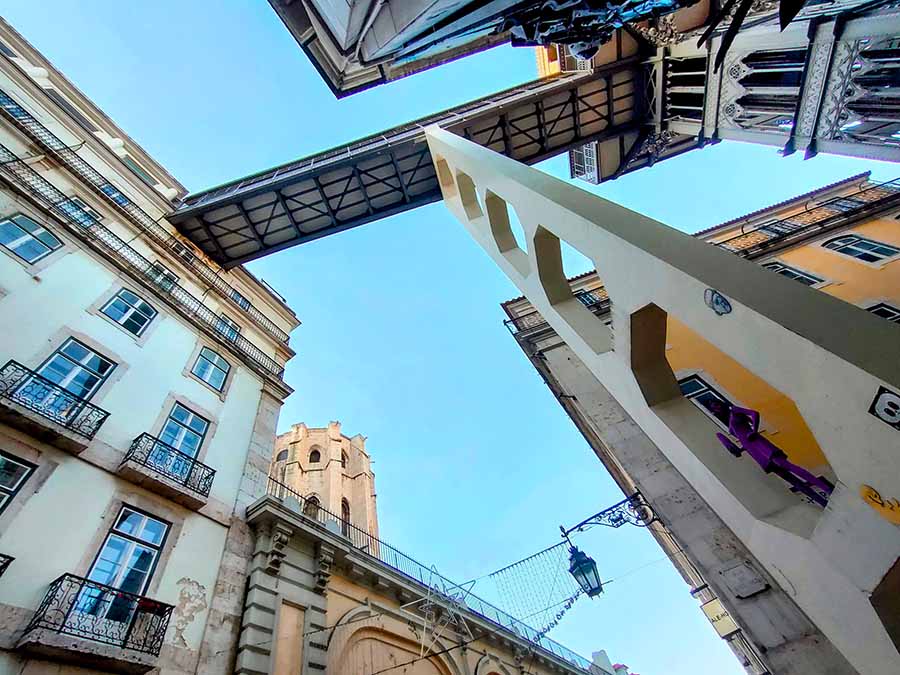
How does Lisbon use solar energy?
Portugal is well-known for its commitment to renewable energy, with solar energy playing a significant role. Thanks to the adoption of solar energy, the price of electricity declined by 89%. Lisbon has launched multiple solar power initiatives, including a significant investment in solar panels on public buildings and schools, to have a cumulative capacity of 103 MW installed by 2030.
The country’s largest project on renewable energy is the 202-megawatt solar energy park with 310.000 solar panels north of Lisbon. This park can supply over 100,000 houses.

One creative implementation of solar energy is the alternative city river and lake transportation with boars working on solar power. The panels installed on the roofs are an eco-friendly solution with no negative impact on the environment.
And some travel info
Get the best deals for flights to Lisbon and find a hotel for an affordable price.
- Take a ride to Belém on a historic tram, explore the Jeronimos Monastery, and visit the nearby Sintra.
- Find the best deal at Feira da Lara, the gem to spend half a day at.
- Dine at the legendary Gambrinus, ordering their croquette, tulipa, and almonds.
- See also 20 facts about Lisbon.
Conclusion

Be it five, ten, or twenty years, countries that possess renewable energy potential will eventually switch to cheaper and cleaner energy sources. These initiatives discussed above are just the beginning of transformation, and the more we talk about the advantages of solar energy, the more people will find it profitable (starting from solar energy at homes to electric cars on the roads). Global environment organizations, in their turn, should double their efforts in raising awareness.








